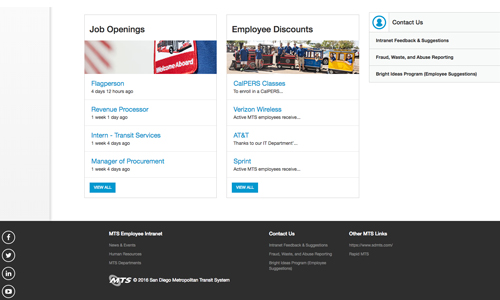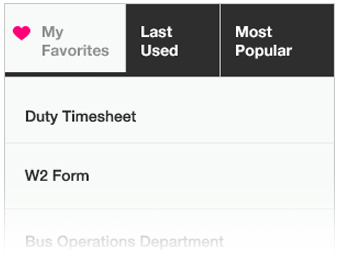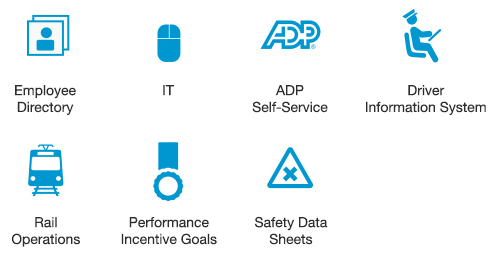
The IT Goals and Strategies support the Agency in achieving its mission and position it for sustained success. These goals and their corresponding strategies ensure that IT is aligned with the Agency’s mission.
Click on the collapsible panel to open and close it.
Provide tools and technology that support meaningful connections across the Agency. Get to know our customers and vendors in order to create and nurture meaningful professional relationships.
1.1 Create Special Interest Groups (SIGs) – Leverage IT to establish cross-departmental groups of co-workers with common business needs or interests. This would be similar and in addition to the SAP SMEs and WGCs.
The IT department must continue to streamline the delivery of services and infrastructure to the Agency. IT and other departmental staff will work together through increased collaboration to address issues affecting the Agency.
2.1 Create an environment that establishes a culture of collaboration – Create an environment that promotes shared efforts across departmental boundaries, encouraging collaboration and innovation.
2.2 Develop new approaches to information sharing and communication that encourage collaboration – Define and implement strategies for cross departmental sharing and professional development, supported by the deployment of collaborative working tools.
2.3 Incorporate stakeholder input into IT actions and decision making – Solicit regular input from IT stakeholders and keep them informed about IT services, projects and progress. Encourage submission of ideas from customer departments to acquire, expand or create new products and applications of technology.
Maintaining and enhancing IT infrastructure is critically important as the foundation for all agency operations. We must ensure that it is reliable, robust, secure and easy to use and that IT staff are available and able to support it. We must continually look ahead to provide the next generation of infrastructure to ensure operational continuity.
3.1 Establish and maintain a Master Plan for infrastructure – Address current and anticipated IT requirements including hardware, software, people and facilities to support business operations.
3.2 Systematically evaluate the greatest potential vulnerabilities – Perform regular security assessments of the infrastructure and remediate weaknesses. Review and update the Master Plan on a regular basis to reflect changing needs and technology.
3.3 Maintain and enhance agency networks – Regularly evaluate the network to ensure that sufficient capacity is maintained to support the Agency’s current and future needs.
3.4 Commit to ongoing professional development of IT staff – Create and maintain an environment that promotes the acquisition of knowledge, skills and attitudes necessary to support an evolving IT environment.
3.5 Communicate available infrastructure – Better define IT services and resources and communicate them to customers and within the IT department.
Data is a key component for decision making and is a valuable resource that must be secured, accessible and preserved. Tools for analytics, sharing and visualization will enhance the success of all customers.
4.1 Provide a robust data-management infrastructure – Provide software, sufficient storage and processing power for current and future needs. Create policies for storage, preservation, protection, access and disposal of data.
4.2 Deploy tools for data analysis – Provide tools to enable stakeholders to locate and extract useful information from data.
4.3 Share best practices and approaches in analytics internally – Provide training and consultancy for stakeholders to enable them to realize the benefits of data resources.
To be an industry leader in improving transit services through the use of information technology, requires sustained investment. Effective IT governance is critical to ensuring that the Agency’s strategic priorities can be supported.
5.1 Establish and maintain IT Governance documentation – Governance structures and processes must be high functioning and align with strategic goals.
5.2 Align resources with agency priorities – Leverage governance to ensure correct prioritization of IT effort across the Agency.
5.3 Continually review IT funding - Ensure that IT funding is maintained in proportion to IT’s increasing contribution to the Agency’s mission.
Technology advances at a rapid pace and if applied creatively and appropriately, it will expedite the achievement of MTS’s business objectives.
6.3 Encourage adoption of IT innovations – Optimize policies and processes to encourage adoption of IT innovations.
6.2 Create an environment that encourages innovation - Facilitate innovative and incremental IT solutions that do not disrupt production systems.
6.1 Develop partnerships for innovation - Partner with stakeholders, subject-matter experts and vendors to promote innovative IT tools providing unique solutions.
Technology advances at a rapid pace and applied creatively and appropriately will expedite the achievement of MTS’s business objectives.

 Employee Directory
Employee Directory IT Help Desk
IT Help Desk ADP Self-Service
ADP Self-Service Driver Information System
Driver Information System Bus Operations
Bus Operations Rail Operations
Rail Operations Performance Incentive Program
Performance Incentive Program Safety Data Sheets
Safety Data Sheets



